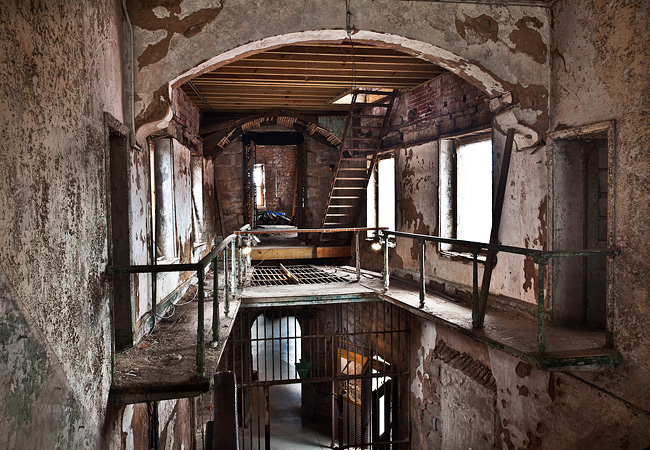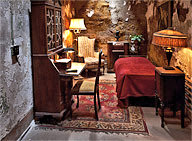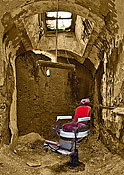|
Scenic USA - Pennsylvania Eastern State Penitentiary |

| Photos by Marty Straub Marty's Eastern State Pen Collection |
Along with the dreams of political independence from England in the later part of the 18th century, Americans also felt the strong desires of social change and betterment. Thomas Jefferson's ideas of individual equality and a natural right to justice echoed some of the main principles of the Age of Enlightenment. In the capital city of Philadelphia, dual goals of reason and equality became deeply imbedded in the public's consciousness. As civic leaders gathered to discuss independence, others took up the cause of prison reform. With the Old Stone Jail  directly under their noses, a place where rapists and murderers were imprisoned with children and petty thieves, concerned citizens formed the Philadelphia Society for Alleviating the Miseries of Public Prisons. Dr. Benjamin Rush's reforms would set the tone during construction of the Eastern State Penitentiary in Philadelphia.
directly under their noses, a place where rapists and murderers were imprisoned with children and petty thieves, concerned citizens formed the Philadelphia Society for Alleviating the Miseries of Public Prisons. Dr. Benjamin Rush's reforms would set the tone during construction of the Eastern State Penitentiary in Philadelphia.
Operational from 1829 to 1971, the Eastern State Penitentiary was the first of its kind, proving to be a model for all prisons that followed. Being the largest and most expensive structure in the country at the time, the prison's unique radial plan was designed by British architect John Havilland. The hub and spoke plan sent out single story cell blocks from an octagonal center.  Individual cells had tap water, flush toilets, rudimentary heat and an individual exercise yard. The design, echoing European Gothic churches, hoped to intimidate its prisoners. The only light in the cell came from an overhead skylight and for some was considered the Eye of God.
Individual cells had tap water, flush toilets, rudimentary heat and an individual exercise yard. The design, echoing European Gothic churches, hoped to intimidate its prisoners. The only light in the cell came from an overhead skylight and for some was considered the Eye of God.
Today, tours offer a close-up look at some of the most intriguing cells. Al Capone's suite (inset) exhibits his fine furniture, oriental rugs, artwork, a radio, and all the luxuries money could buy. Highlighted with rays from a skylight in a background of chipped paint and spalling concrete, Capone's barber chair (inset) creates a stirring site.
Closed after 142 years of incarcerating 75,000 prisoners, the East Pen was declared a National Landmark in 1965. Open daily from 10 to 5, the prison is an excellent history lesson of how moral ambitions are easily overturned to the harsh reality of cost effective confinement.
Area Map

|
Nearby Points of Interest |
|
Copyright © 2021 Benjamin Prepelka
All Rights Reserved
